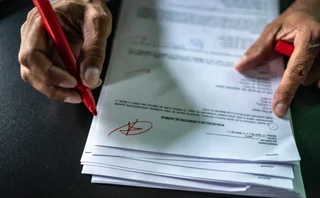

Model change pumps up Deutsche’s VAR capital charge
Switch to historical simulation approach increases requirement by 71%
Shifting to a historical simulation approach to calculating its trading risks added millions of euros to Deutsche Bank’s value-at-risk based capital requirement over the last three months of 2020.
As of end-2020, required capital to cover market risks assessed using its souped-up internal model totalled €2.1 billion ($2.5 billion), up just half-a-percentage point on end-September. However, the VAR-based component of this charge soared 71% to €969 million over the period. The bank said this was
Only users who have a paid subscription or are part of a corporate subscription are able to print or copy content.
To access these options, along with all other subscription benefits, please contact info@risk.net or view our subscription options here: http://subscriptions.risk.net/subscribe
You are currently unable to print this content. Please contact info@risk.net to find out more.
You are currently unable to copy this content. Please contact info@risk.net to find out more.
Copyright Infopro Digital Limited. All rights reserved.
As outlined in our terms and conditions, https://www.infopro-digital.com/terms-and-conditions/subscriptions/ (point 2.4), printing is limited to a single copy.
If you would like to purchase additional rights please email info@risk.net
Copyright Infopro Digital Limited. All rights reserved.
You may share this content using our article tools. As outlined in our terms and conditions, https://www.infopro-digital.com/terms-and-conditions/subscriptions/ (clause 2.4), an Authorised User may only make one copy of the materials for their own personal use. You must also comply with the restrictions in clause 2.5.
If you would like to purchase additional rights please email info@risk.net
More on Risk Quantum
EU IMA users maintain edge in keeping risk charges compressed
Aggregate market RWAs increased slower in 12 months to June than at banks using SA only
OTC derivatives hit $730 trillion peak in H1 2024
Interest rate and FX derivatives drive notional spike
G-Sib cross-border risk drops to four-year low
Two-thirds of systemic banks saw systemic indicator decrease in 2023
Thirteen EU banks face loan losses of more than 16% from green switch
Climate stress test predicts overall bank losses of 6%, rising to 11% under adverse scenarios
Deutsche misses G-Sib surcharge cut despite EU score benefit
Carve-out of intra-bloc exposure lowers score below 230bp, but 1.5% surcharge remains
Post-UBS takeover, Switzerland sees biggest regional G-Sib score spike
Credit Suisse acquisition pushes UBS’s complexity category to all-time high, driving up country’s overall score
Deutsche’s IRC tops €8 billion in four-year high
Ballooning credit-event risk charge contrasts with Q3 drop at BNP Paribas, ING
Fed’s stricter G-Sib scoring punishes BofA, Goldman
Duo’s method 2 capital requirements will diverge further from those entailed by Basel’s methodology







